

Advanced Health & Fitness Specialist Certification - American Council on Exercise (ACE) Fitness Certifications. Millions of people every year are affected by stroke, heart attack, hypertension, osteoporosis, mobility-related injury and illness.

A number of different factors, including longer life spans and the obesity epidemic, have also led to a much higher incidence of people with multiple health conditions. While our health challenges as a population have become more complex, our desire to live full, rewarding lives has remained unchanged. There are hip-replacement patients who want to run again, Type 2 diabetics who rely on medication to regulate their blood sugar levels, and people with chronic low-back pain who don’t want to live in constant discomfort.
That’s where ACE-certified Advanced Health and Fitness Specialists come in. They have the expertise to work with clients who have multiple health issues, and develop post-rehabilitative fitness programming for people recovering from cardiovascular, pulmonary, metabolic and musculoskeletal issues. Why Choose ACE? Fitness Fact Get Started Today. Understanding the AHFS. August 22, 2011, 12:00AM PT in Exam Preparation Blog | Most of us know or at least have an idea about what a Personal Trainer or Group Fitness Instructor does, but when it comes to the job description of an Advanced Health and Fitness Specialist there might be some questions.
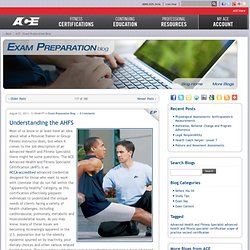
The ACE Advanced Health and Fitness Specialist Certification (AHFS) is an NCCA-accredited advanced credential designed for those who want to work with clientele that do not fall within the “apparently healthy” category, as this certification effectively prepares individuals to understand the unique needs of clients facing a variety of health challenges, including cardiovascular, pulmonary, metabolic and musculoskeletal issues. As you may know, many of these issues are becoming increasingly apparent in the U.S. population due to the obesity epidemic spurred on by inactivity, poor dietary choices and other various related health factors.
Another certification…really? How did you learn page 169 (nasm) ... any printouts of page? Sitting at Your Desk Is Eating Your Muscles. Do you work an office job and sit all day?
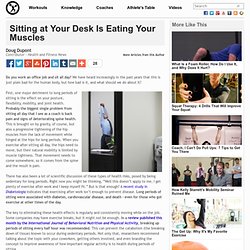
We have heard increasingly in the past years that this is just plain bad for the human body, but how bad is it, and what should we do about it? First, one major detriment to long periods of sitting is the effect on your posture, flexibility, mobility, and joint health. Probably the biggest single problem from sitting all day that I see as a coach is back pain and signs of deteriorating spine health.
This is brought on by gravity, of course, but also a progressive tightening of the hip muscles from the lack of movement while hinged at the hips for long periods. When you exercise after sitting all day, the hips need to move, but their natural mobility is limited by muscle tightness. There has also been a lot of scientific discussion of these types of health risks, posed by being sedentary for long periods.
The key to eliminating these health effects is regularly and consistently moving while on the job. Why Screening and Corrective Exercise Should Be the Foundation of Every Exercise Program. Functional exercise, prehabilitation, and corrective exercises are growing exponentially and being addressed in everything from Runner’s World, Men’s Health, collegiate strength and conditioning journals, and more.
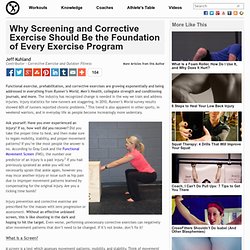
The industry has recognized change is needed in the way we train and address injuries. Fitness Business Coaching - John Spencer Ellis & Kelli Calabrese. An easy way to remember arm muscles PART 1. Interactive Tutorials and Quizzes On Human Anatomy and Physiology. VMO Activation. Lower Cross Syndrome. Upper Cross Syndrome. Tensor Fascia Latae and Iliotibial Band – Functional Evaluation - Dr.Jeffrey Tucker.
Posted by DrTucker in Articles by Dr.

Tucker on 09 1st, 2009 | no responses by Jeffrey H. Tucker, DC, DACRB The tensor fascia latae (TFL) acts through the iliotibial tract by pulling it superiorly and anteriorly. It assists in flexing, medial rotation and abduction of the hip and extension of the knee joint. Muscle length imbalance (or muscle weakness) is a common occurrence that occurs in the synergistic muscles in the hip: Flexors: The TFL becomes short and the iliopsoas becomes a long and/or weak muscle.
The difference in the length of two synergistic muscles contributes to compensatory joint motion and the development of movement impairment. Vastus Lateralis SA Static Release. 20 Things I'm Thinking About. By Mike Robertson Last year, I wrote an article titled 28 Things I'm Learning.
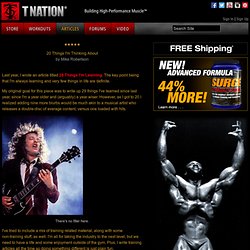
The key point being that I'm always learning and very few things in life are definite. My original goal for this piece was to write up 29 things I've learned since last year, since I'm a year older and (arguably) a year wiser. However, as I got to 20 I realized adding nine more blurbs would be much akin to a musical artist who releases a double-disc of average content, versus one loaded with hits.
There's no filler here. I've tried to include a mix of training related material, along with some non-training stuff, as well. Fixing the Flaws: A Look at the Ten Most Common Biomechanical Weak Links in Athletes. Written on January 31, 2008 at 9:00 am, by Eric Cressey By Eric Cressey Originally featured at charlespoliquin.net Even the best athletes are limited by their most significant weaknesses.
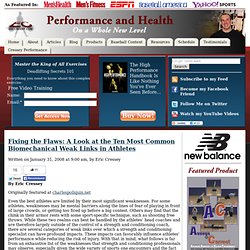
For some athletes, weaknesses may be mental barriers along the lines of fear of playing in front of large crowds, or getting too fired up before a big contest. Others may find that the chink in their armor rests with some sport-specific technique, such as shooting free throws. 1. 2. Regarding the optimal integration of posterior chain work, I’m referring to the fact that many athletes have altered firing patterns within the posterior chain due to lower crossed syndrome. 3. 4. 5. 6. 7 & 8.
Although each of the four muscles of the rotator cuff contributes to humeral motion, their primary function is stabilization of the humeral head in the glenoid fossa of the scapula during this humeral motion.